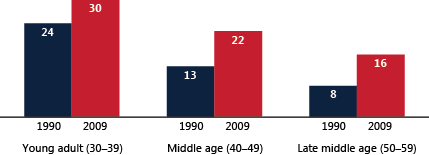Marriage Trends and the Effects on Women's Benefits
April 2013A significantly larger proportion of women were ineligible for Social Security spousal and survivor benefits in 2009 than in 1990 due to changes in marital trends
For example, in 2009, 16 percent of women aged 50–59 had marital histories that made them ineligible for spousal or survivor benefits, compared with 8 percent in 1990. 1, 2
This change is driven by increasing proportions of women who never marry and, to a lesser extent, a rise in divorced women without a 10-year marriage
In 2009, 9 percent of women aged 50–59 had never married compared with 5 percent in 1990. 1 This trend may reduce some women's retirement income, particularly in groups with limited economic resources.
There are sharp differences in eligibility for spousal and survivor benefits based on variations in marital history by race and ethnicity
A decline in marriage rates has been more pronounced among black women of more recent birth cohorts relative to white women. For example, in 2009, around 22 percent of black women aged 50–59 had never married compared with 7 percent of comparable white women. In 1990, the share of never married was 8 percent and 4 percent respectively. 3

NOTES: All content is simplified for presentation. Please see source material for full details and caveats.
The findings and conclusions presented in this summary are those of the authors and do not necessarily represent the views of the agency.
Background
- In addition to retired or disabled worker benefits, the Social Security program provides benefits to spouses or widow(er)s of insured workers.
- Eligibility for spousal or survivor benefits depends on a person's marital history and his or her lifetime earnings relative to a current or previous spouse.
- Under the marital history requirement, a person must be currently married, widowed, or divorced from a marriage of at least 10 years. 4
Key Terms
Potential eligibility for spousal or survivor benefits does not imply actual receipt.
1 Iams, Howard M. and Christopher R. Tamborini. 2012. "The Implications of Marital History Change on Women's Eligibility for Social Security Wife and Widow Benefits, 1990–2009." Social Security Bulletin 72(2): 23–38.
2 Women's declining potential eligibility for spousal and survivor benefits will not necessarily lead to reduced retirement well-being, as increasing labor force participation and earnings will provide some women with higher benefits based on their own earnings records than they would have received as a spouse or survivor with a qualifying marriage.
3 Tamborini, Christopher R., Howard M. Iams, and Kevin Whitman. 2009. "Marital History, Race, and Social Security Spouse and Widow Benefit Eligibility in the United States." Research on Aging 31(5): 577–605.
4 For survivor benefits, there is generally a 9-month marital duration requirement, but exceptions exist, see SSA FAQ #KA-01999.